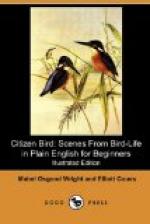[Illustration: Yellow-Breasted Chat.]
“Some day in the nesting season you may see the Chat fly up in the air and hear him sing his courting song, which is very sweet, different from all his jests and jeers. You will say, if you are near enough to take a long look—’Why, that Chat has forgotten to fold up his legs, they are hanging straight down.’ He has not forgotten, however; it is merely one of his odd habits at this season to cut all sorts of capers in the air, with his legs and wings and tail let loose, while his mate is quietly house-keeping in some thick bush near by. The nest is something like a Catbird’s, not very tidy outside, but snug inside, and easy to find if you look in the right place. If you find it at the right time you will see that it holds four or five well-rounded eggs of a crystal-white color, with plenty of bright reddish-brown spots all over them.”
The Yellow-breasted Chat
Length seven and a half inches—much more than any other Warbler measures.
Upper parts bright olive-green, even all over.
Lower parts very bright yellow on the throat, breast, and wing-linings, but the belly pure white.
A strong dark-colored beak, with some dark and light marks between it and the eyes.
A Summer Citizen of the United States east of the plains and south of Ontario and Minnesota; travels far south in winter. When he is found west of the plains his tail is somewhat longer, and he is called the Long-tailed Chat.
Chiefly a Tree Trapper, but also a Seed Sower.
THE AMERICAN REDSTART
“The Redstart is the dancing Warbler, just as the Chat is the joker. He never flies along in a sober, earnest fashion, as if his business was of real importance. When on the ground he skips and hops, then takes a few short steps and a little dance backward. In the trees, where he also feeds and where in some crotch he lashes his pretty nest of leaf-stalks, moss, and horse-hair, he moves about as suddenly as can be imagined, and he has a way of flying up and backward at the same time that makes him a very confusing bird to watch. In flitting among the branches, or darting into the air for gnats, his colors make him look like a tiny Oriole.”
“Oh, uncle! Uncle Roy!” cried Dodo, who had been looking along the path, “there are two of the dearest little birds down there, and one of them is red and black as you say the Redstart is, and the other is shaped like it but has brown and yellow feathers, and they move along as if the wind was blowing them!”
[Illustration: American Redstart. 1. Male. 2. Female.]
Before Dodo stopped speaking the whole party were looking where she pointed, Olive using the field-glass.
“Those are a pair of Redstarts,” she said, “and they are picking up ants. I saw a number of little anthills there yesterday.”




